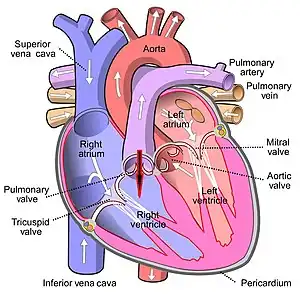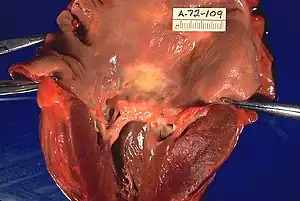Pulmonary valve insufficiency
| Pulmonary valve insufficiency | |
|---|---|
| Other names: Pulmonary regurgitation, pulmonary incompetence | |
 | |
| Diagram of the heart with a black arrow showing the location and direction of the abnormal blood flow | |
| Specialty | Cardiology |
| Symptoms | Few symptoms initially, may develop shortness of breath with exercise[1] |
| Complications | Heart failure, ventricular arrhythmia, tricuspid regurgitation[1] |
| Causes | Pulmonary hypertension, surgical valvulotomy, balloon valvuloplasty, carcinoid syndrome, infective endocarditis, rheumatic heart disease, congenital valve disease[1] |
| Diagnostic method | Suspected based on a diastolic murmur, confirmed by echocardiogram[1] |
| Differential diagnosis | Aortic regurgitation, pulmonary emboli, constrictive pericarditis[1] |
| Treatment | Active monitoring, pulmonary valve replacement[1] |
| Frequency | Severe disease is rare[2] |
Pulmonary valve insufficiency, also known as pulmonary regurgitation, is a type of valvular heart disease in which there is backward flow of blood from the pulmonary artery, through the pulmonary valve, into the right ventricle, when the heart relaxes.[1] Most people have no symptoms.[1] When symptoms do occur these may include shortness of breath with exercise, leg swelling, and an enlarged liver.[1] Complications may include heart failure, ventricular arrhythmia, and tricuspid insufficiency.[1]
Causes may include pulmonary hypertension, surgical valvulotomy, balloon valvuloplasty, carcinoid syndrome, infective endocarditis, rheumatic heart disease, or congenital valve disease.[1] It commonly occurs in people with tetralogy of Fallot as the surgery to correct the abnormality can result in pulmonary valve issues years later.[1] The diagnosis may be suspected based on a diastolic murmur and confirmed by an ultrasound of the heart.[1]
Yearly ultrasounds may be recommended in those at risk.[1] In those with pulmonary hypertension, that should be treated.[2] In those with symptoms, pulmonary valve replacement may be recommended.[1] The tricuspid valve may benefit from being repaired at the same time.[1] In those unable to have surgery, diuretics, ACE inhibitors, and beta-blockers may be used to treat heart failure.[1] Outcomes can be good with surgery.[1]
Severe pulmonary valve insufficiency is rare.[2] A small to moderate amount of back flow may normally occur.[1][3] The murmur of pulmonary valve insufficiency was first described in 1873 by George Balfour and later in 1888 by Graham Steell.[4][5] It was further described by William Osler in 1892, at which time it was considered of little importance.[6]
Signs and symptoms
Because pulmonic regurgitation is the result of other factors in the body, any noticeable symptoms are ultimately caused by an underlying medical condition rather than the regurgitation itself.[7] However, more severe regurgitation may contribute to right ventricular enlargement by dilation, and in later stages, right heart failure.[8] A diastolic decrescendo murmur can sometimes be identified,( heard best) over the left lower sternal border.
Causes

Among the causes of pulmonary insufficiency are:
- Pulmonary hypertension[9]
- Infective endocarditis[9]
- Rheumatic heart disease[9]
- Connective tissue disease[8]
- Carcinoid syndrome[8]
- Congestive abnormalities[10]
- Tetralogy of Fallot,[11]
- Prosthetic heart valve[12]
Pathophysiology
The pathophysiology is due to diastolic pressure variations between the pulmonary artery and right ventricle, differences are often very small, but increase regurgitation. An elevation in pulmonary insufficiency due to elevated intrathoracic pressure is relevant in ventilated patients (having acute restrictive right ventricular physiology). The reasons for changes in stiffness of the right ventricle's walls are not well understood, but such stiffness is thought to increase with hypertrophy of the ventricle.[13]
Diagnosis
In the diagnosis of pulmonary insufficiency both echocardiograms and EKG is used to ascertain if the individual has this condition, as well as, the use of a chest x-ray to expose enlargement of the right atrium or ventricle.[14]
If it is secondary to pulmonary hypertension it is referred to as a Graham Steell murmur.[15]
Treatment
In treating pulmonary insufficiency, it should be determined if pulmonary hypertension is causing the problem to therefore begin the most appropriate therapy as soon as possible (primary pulmonary hypertension or secondary pulmonary hypertension due to thromboembolism).[16] Furthermore, pulmonary insufficiency is generally treated by addressing the underlying condition,[7] in certain cases, the pulmonary valve may be surgically replaced.[17]
See also
References
- 1 2 3 4 5 6 7 8 9 10 11 12 13 14 15 16 17 18 19 Saji, AM; Sharma, S (January 2020). "Pulmonary Regurgitation". PMID 32491496.
{{cite journal}}: Cite journal requires|journal=(help) - 1 2 3 "Pulmonic Regurgitation - Cardiovascular Disorders". Merck Manuals Professional Edition. Archived from the original on 1 December 2020. Retrieved 22 December 2020.
- ↑ Gill, Edward A.; Sugeng, Lisa; Lang, Roberto (2012). Atlas of 3D Echocardiography E-Book: Expert Consult – Online. Elsevier Health Sciences. p. 176. ISBN 978-1-4557-4238-7. Archived from the original on 2021-08-29. Retrieved 2020-12-22.
- ↑ Elwood, Willis J.; Tuxford, Ann Félicité (1984). Some Manchester Doctors: A Biographical Collection to Mark the 150th Anniversary of the Manchester Medical Society. Manchester University Press. p. 210. ISBN 978-0-7190-1754-4. Archived from the original on 2021-08-29. Retrieved 2020-12-22.
- ↑ III, James A. Stockman (2012). Year Book of Pediatrics 2012 - E-Book. Elsevier Health Sciences. p. 231. ISBN 978-0-323-08974-6. Archived from the original on 2021-08-29. Retrieved 2020-12-22.
- ↑ MD, Joseph K. Perloff; Marelli, Ariane (2012). Perloff's Clinical Recognition of Congenital Heart Disease: Expert Consult - Online and Print. Elsevier Health Sciences. p. 169. ISBN 978-1-4377-1618-4. Archived from the original on 2021-08-29. Retrieved 2020-12-22.
- 1 2 McGlothlin, edited by Michael H. Crawford, Komandoor Srivathson, Dana P. (2006). Current consult. New York, NY: Lange Medical Books/McGraw-Hill. p. 269. ISBN 978-0-07144-010-3.
- 1 2 3 "Pulmonic Regurgitation Clinical Presentation". Medscale.com. eMedicine. Archived from the original on 22 August 2017. Retrieved 29 August 2015.
- 1 2 3 Booker, editors, Carol L. Lake, Peter D. (2005). Pediatric cardiac anesthesia (4th ed.). Philadelphia: Lippincott Williams & Wilkins. p. 430. ISBN 978-0-7817-5175-9. Archived from the original on 12 August 2020. Retrieved 30 August 2015.
- ↑ "pulmonary Valve disease". Patient.info. EMIS Group. Archived from the original on 5 April 2020. Retrieved 29 August 2015.
- ↑ Alpert, Joseph (2012). Cardiology and the Primary care Physician (3rd ed.). Current Medicine. p. 306. ISBN 978-1-4615-6603-8. Archived from the original on 12 August 2020. Retrieved 29 August 2015.
- ↑ O'Connor, Nicholas J. Talley, Simon (2014). Clinical examination : a systematic guide to physical diagnosis (Seventh ed.). Sydney [etc.]: Elsevier, Churchill Livingstone. p. 108. ISBN 978-0-72954-147-3. Archived from the original on 11 August 2020. Retrieved 29 August 2015.
- ↑ Chaturvedi, Rajiv R; Redington, Andrew N (2007-07-01). "Pulmonary regurgitation in congenital heart disease". Heart. 93 (7): 880–889. doi:10.1136/hrt.2005.075234. ISSN 1355-6037. PMC 1994453. PMID 17569817.
- ↑ "Pulmonary Valve Disease. About Pulmonary valve disease | Patient". Patient. Archived from the original on 2020-04-05. Retrieved 2015-08-29.
- ↑ Auscultation Skills: Breath & Heart Sounds. Lippincott Williams & Wilkins. 2009-10-01. p. 83. ISBN 9781605474540. Archived from the original on 2016-04-25. Retrieved 2015-08-29.
- ↑ "Pulmonic Regurgitation Treatment & Management: Medical Care, Surgical Care, Consultations". 2018-06-28. Archived from the original on 2017-09-19. Retrieved 2015-08-29.
{{cite journal}}: Cite journal requires|journal=(help) - ↑ "Heart valve surgery: MedlinePlus Medical Encyclopedia". www.nlm.nih.gov. Archived from the original on 2021-03-01. Retrieved 2015-08-30.
Further reading
- Lake, Carol L.; Booker, Peter D. (2005-01-01). Pediatric Cardiac Anesthesia. Lippincott Williams & Wilkins. ISBN 9780781751759. Archived from the original on 2016-04-27. Retrieved 2015-08-29.
- Bruce, Charles J.; Connolly, Heidi M. (2009-05-26). "Right-Sided Valve Disease Deserves a Little More Respect". Circulation. 119 (20): 2726–2734. doi:10.1161/CIRCULATIONAHA.108.776021. ISSN 0009-7322. PMID 19470901.
- M.D, Steven Lehrer (2011-12-27). Understanding Pediatric Heart Sounds. Steven Lehrer. ISBN 9781468138030. Archived from the original on 2016-04-25. Retrieved 2015-08-29.
External links
- "Problem: Pulmonary Valve Regurgitation". www.heart.org. Archived from the original on 2015-08-27. Retrieved 2015-08-29.
| Classification | |
|---|---|
| External resources |